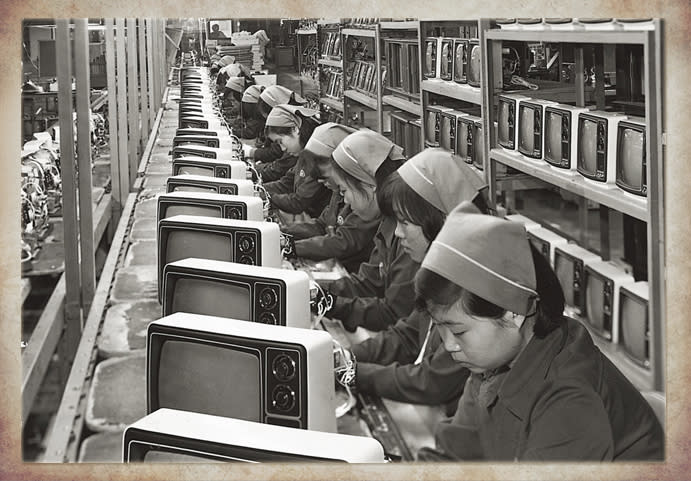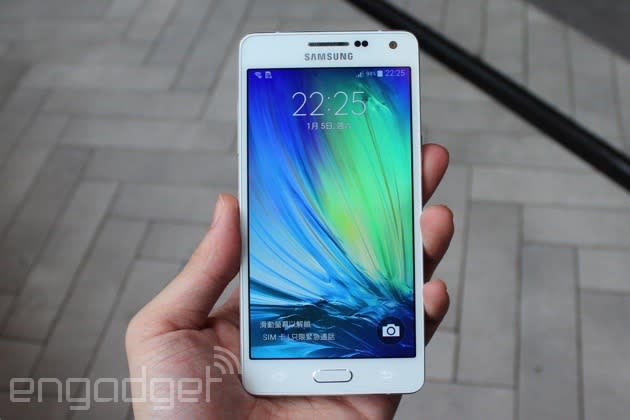How Samsung became the king of CES and where it's going next

Long before Transformers director Michael Bay choked onstage at Samsung's lavish CES 2014 press conference, the Korean company was just another electronics outfit begging for attention. But after decades at CES, Samsung is now the undisputed king of the show. Its blowout media events are the largest and most difficult to get into. Samsung Electronics CEO BK Yoon is kicking off the show next month by hosting the prestigious opening keynote. And it's one of the few tech giants left standing at CES, as Microsoft and others abandon it. Samsung's glorious rise mirrors its ascent in the mobile industry, and it's also yet another example of the company's oft-repeated formula for success: Time, money and perseverance lead to victory.

A group of Samsung workers putting together black-and-white TVs.
A Look Back
Samsung Electronics, the consumer technology subsidiary of the 76-year-old Samsung conglomerate, was founded in 1969. It's what we typically refer to when we talk about Samsung (its parent company is involved in drier business like insurance and petrochemicals). Samsung started out in home electronics by making black-and-white TVs and refrigerators during the '70s. It didn't waste any time ramping up its offerings, though: It quickly expanded to color televisions and microwaves later in the decade. Samsung also began exporting its wares and launched an American outpost in 1978 with international expansion in mind. A merger with the conglomerate's semiconductor business in 1988 also set the stage for Samsung Electronics to become the chip giant we know today.
Rather than being a place to launch its new devices, CES was like a pageant that allowed Samsung to flaunt its consumer technology strength.
Like many technology companies hoping to make a splash in the '80s, Samsung was a familiar presence at CES, where it showed off newfangled products like VCRs, projection TVs and desktop computers. Samsung produced its 20 millionth color TV in 1989 and won a bit of fame a few years earlier by developing the world's smallest 4mm videotape recorder. Throughout the decade, it made steady leaps in memory technology -- it was the third company in the world to develop 64KB DRAM, and it launched the industry's first 256K DRAM chip in 1984. Samsung held onto that memory momentum throughout the '90s, where it was the first to launch 64MB, 256MB and 512MB RAM chips. By 1992, it was the world's largest memory chip producer.

Samsung's diverse product line during the 1970s.
Samsung continued to make plenty of consumer gadgetry through the '90s -- its 10 CES Innovation Award winners in 1997 included a DVD player, computer monitor and fax machine -- but really, it was a decade where the company spent far more effort establishing itself as a component giant. On top of its innovations in the memory market, Samsung developed its first LCD panel in 1995, created the world's first 30-inch LCD screen in 1997 and by 1998, it led the LCD market. That was long before LCD screens were commonplace, but it certainly put Samsung in a comfortable spot by the time that technology invaded every screen in our lives.
The HDTV era
Samsung was no stranger to CES, but the post-2000 HDTV race gave the company something truly impressive to have attendees drool over: giant TVs with resolutions far beyond what anyone had in their living rooms. HDTV was something the CES crowd had been dreaming about for over a decade (it was a major story in Wired's first issue in 1993), but with the dawn of the new millennium, it was finally within reach. Like most other TV makers, Samsung showed off a range of HDTV options at CES throughout the 2000s, including LCD, plasma and DLP sets. HDTVs were the ideal new technology for CES -- it was the rare innovation that actually lived up to years of hype drummed up by the show, and it was so transformative it was worth fighting the horrendous CES crowds to see.

Engadget editor Ben Gilbert takes in Samsung's transforming, curved OLED HDTV.
Samsung's foresight with LCD development ended up paying off in a big way. On top of becoming one of the leading HDTV makers, the company also provided panels to plenty of other companies for televisions, computers and mobile devices. Even Sony ended up striking a deal with Samsung -- in 2006 they formed the joint company S-LCD to ensure a steady supply of large LCD panels. Samsung ended up buying out Sony's stake in the project in late 2011, and it later rolled it up with its own mobile display unit.
After more than a decade in the spotlight at CES, HDTVs aren't going away anytime soon. After the flop that was 3D TVs, now the CES crowd is focusing on 4K, smart TVs and other gimmicks (like Samsung's transforming, curved OLED TV above). Today, 4K sets are surprisingly affordable, and we're finally getting some 4K content from Netflix and Amazon. It'll be interesting to see if Samsung can give consumers a reason to dump their existing HDTVs. Samsung also demonstrated a large 8K set last January, which looked so clear it was as if I was looking through a window. That tech may never be suitable for living rooms, but I'm hoping it's something we can see in theater projectors eventually.
The mobile revolution
Samsung was already a player in the mobile world long before the iPhone hit the scene, but with smartphones it had the opportunity to bring together all of its component smarts in a single device. And it probably helped that Samsung manufactured Apple's iPhone processor (up to and including the A7 in the iPhone 5s). With its expertise developing LCDs, memory chips and processors, Samsung was in a far better position than any other company to develop a true iPhone competitor. (Nokia could have been a contender, but... well we know how that turned out.)
With the announcement of the Galaxy S in March 2010, Samsung made it clear it wanted to be a big deal in mobile. Notably, the company announced the phone at the CTIA conference that year -- not CES. But the Galaxy S, and indeed all of Samsung's follow-up devices, were a big part of its CES presence over the following years. Rather than being a place to launch its new devices, CES was like a pageant that allowed Samsung to flaunt its consumer technology strength.

Samsung's "premium-designed" Galaxy Alpha.
While the Galaxy S was a popular device for its time, Samsung's grand plan to take over the mobile industry really got into gear with the Galaxy S II in 2011. It was a faster and sleeker device, and it also built on the Galaxy S' smart multi-carrier strategy in the US. The S II also pushed Samsung to become the world's top phone maker in early 2012, unseating Nokia in the process. By the time the Galaxy S III came around the following year, all of the pieces were in place for it to be a smash hit. It had a gorgeous 4.8-inch screen, while the iPhone was still stuck with a tiny 3.5-inch display. And it packed in some of the best specs we'd ever seen in an Android phone. Perhaps most importantly, Samsung was able to market the heck out of the thing. It was a powerful Android phone that didn't just appeal to geeks, which was a rare sight in those days.
As someone who's attended every CES since 2011, I've seen Samsung's stature at the show grow first-hand. That year featured one of the first truly insane Samsung keynotes, which for some reason starred a kid from the future and a whole bunch of dancers. After that, the tech world quickly learned to expect a bit of zaniness from every Samsung event, often in the form of random "comedy" and dance numbers. Samsung's like the forever awkward nerd who accidentally got cool -- no matter how successful it becomes, it'll always be a bit dorky. Naturally, it got tougher to get into Samsung's CES press conferences -- I only had to wait around 30 minutes in line in 2011, but last year it took over two hours.
Samsung's like the forever awkward nerd who accidentally got cool -- no matter how successful it becomes, it'll always be a bit dorky.
Neither Samsung nor the Consumer Electronics Association (which organizes CES) would chat with us for this piece, so I don't have any hard numbers to prove its rise in popularity. But in my time at the show, I've seen nothing but larger crowds at Samsung's events. It also has one of the biggest booths at the show, which is typically packed to the brim with everything the company's got cooking -- phones, tablets, giant TVs and technology we may not even see for years. Sony's one of the few competitors with a similarly sized CES booth, but it's not as densely filled with gear. And when I strike up conversations with CES attendees, the conversation inevitably steers toward Samsung.
Of course, the Korean electronics giant benefits when other companies give up on CES entirely. Microsoft hasn't had a booth at the show since 2012, when then-CEO Steve Ballmer hosted his last opening keynote. And even if they're present, plenty of companies are downgrading their booths and dramatically reducing the amount of people they send to the show. It typically makes more sense to announce news outside of the insanity of CES -- and if you can invite media to a controlled environment of your own, all the better. Samsung's one of the few companies that can afford to have it both ways.

Samsung Electronics CEO and President BK Yoon.
The Road Ahead
Samsung's still holding onto its mobile throne, even though its market share has been steadily slipping over the last few quarters. In particular, it's being threatened by Chinese phone makers like Huawei (which will be at CES) and Xiaomi (which won't). They're developing powerful phones that are also surprisingly affordable -- something Samsung hasn't yet figured out.
The challenge for Samsung and every other IoT company is figuring out a way to make connected devices seem more than just hype.
But the company is also looking beyond mobile. Yoon (above) says his CES keynote will focus on the internet of things (IoT) and how it will "unlock infinite possibilities." Samsung snapped up the IoT company SmartThings last August, so it's likely planning a way to repeat its mobile success with connected devices. Just like HDTV, IoT is one of those things CES presenters and attendees have been talking about for years. But unlike HDTV, it's not clear yet why mainstream consumers need connected devices.
The challenge for Samsung and every other IoT company is figuring out a way to make connected devices seem more than just hype. Nest and Quirky have been doing a decent job of selling their wares to early adopters, but for IoT to succeed it'll need to appeal to everyone. And that'll be much tougher than just getting people to buy a shiny new phone.
[Photos: Joe Klamar/AFP/Getty Images (Samsung CES booth); Samsung Electronics]
